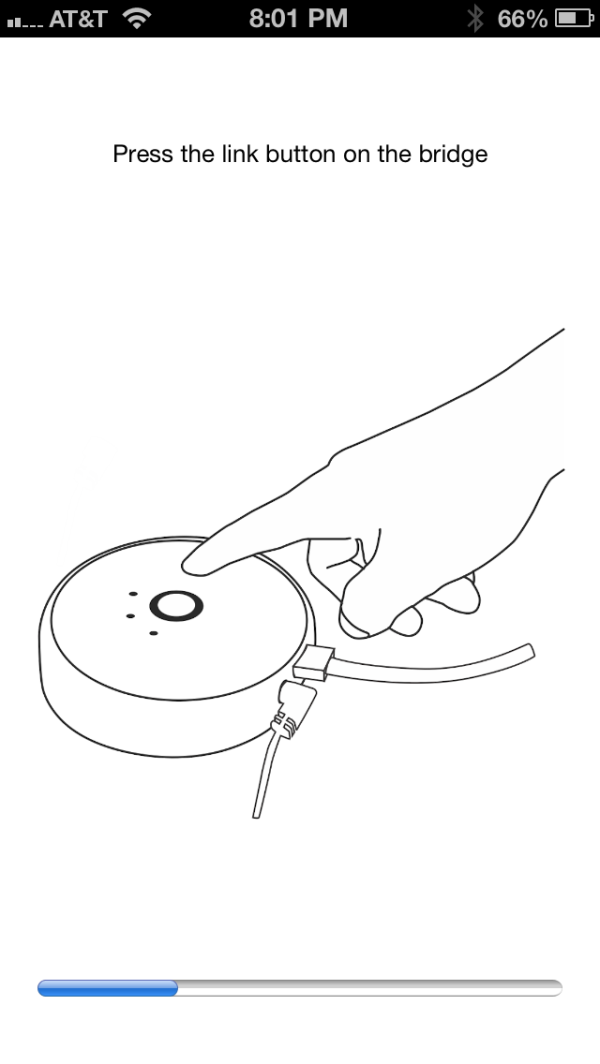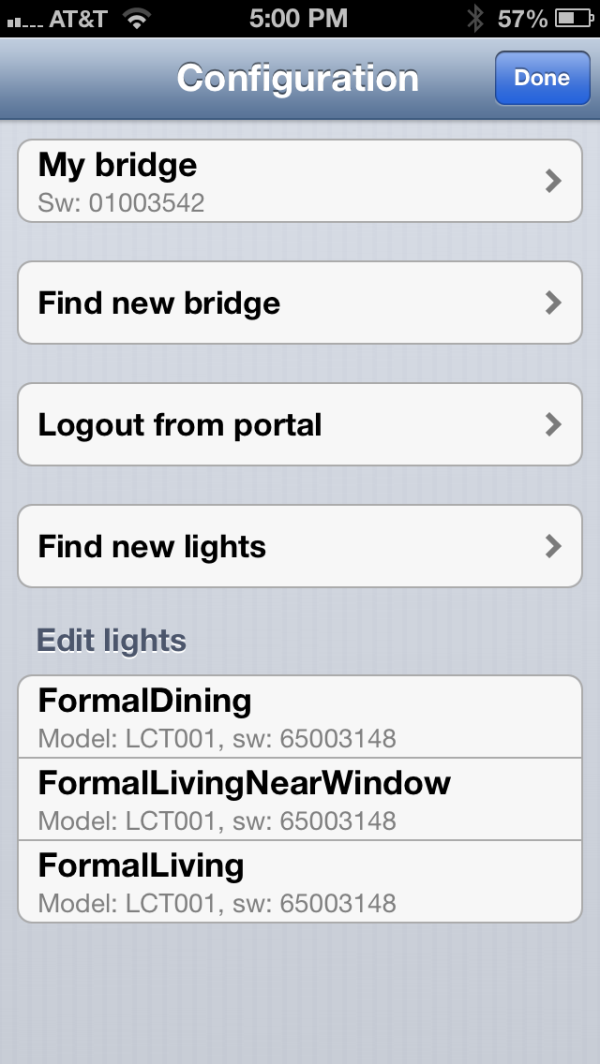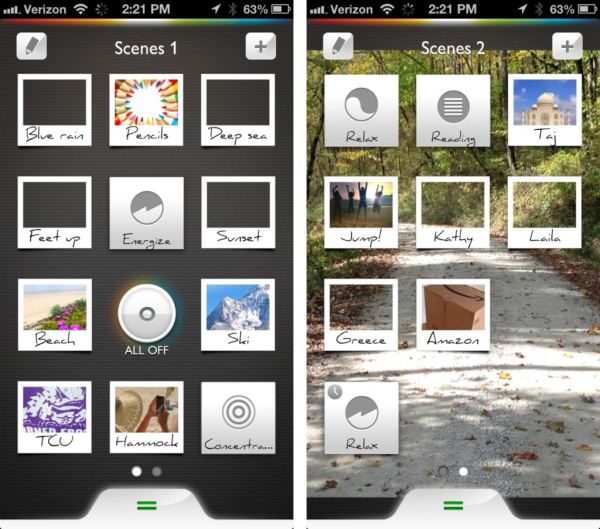Philips Hue: Automated Home Lighting Gets Colorful
by Ashu Joshi on March 1, 2013 12:50 AM EST- Posted in
- Gadgets
- Home Automation
- Philips
- Hue
- Lighting
Philips Hue Setup
The setup process is very easy and at no point do you need a PC or a Mac computer—everything can be done using a Smartphone or a Tablet. The first step for any automation controller that can be controlled over the Home Network or Internet is to get it on the Network, naturally. Philips makes this easy by sticking with Ethernet for the Hue Bridge.
As far as the setup procedure, the first step is to screw in the Connected Bulbs and turn them on. All the bulbs turn on just like normal light bulbs, with a default white light. Once all the bulbs are screwed in and powered on, plug the Hue Bridge into an Ethernet port connected to your home router/gateway and apply power.
The Hue Bridge boots in less than 20 seconds (you can see the boot process in this short video). The next step is to install the app from the Apple App Store on your iOS device (or the Google Play Store for Android).At this point, make sure that your smartphone WiFi is on and connected to your home network. Fire up the app and it will instruct you to press the “link” button on the controller. When you press the button the app discovers the Hue Bridge and you should be ready to go. In my case, it automatically discovered all the three bulbs and they showed up in the app.
From the App settings section it’s possible to rename each bulb to give it a meaningful location. To help with this process, when you select one of the bulbs in the app the corresponding physical bulb starts blinking to show you which light you’re adjusting. This is a handy feature for the initial setup, and it could be even more important if you happen to have a lot of Connected Bulbs.
The app comes with multiple scenes that set the lighting ambience to predefined levels. You can also snap a photo and let the app decide on the appropriate color(s), and you can save all of these settings to new “scenes” (e.g. you might have one setting for a regular dinner with a different settings for a “romantic dinner”). There is also an option in the app to add more Bridges or bulbs, but I have not been able to try that yet. It seems pretty straightforward: adding a new bulb takes you to a page on the Smartphone that instructs you to screw in the new light, turn power on, and start the search.
It’s also possible to control Hue from more than one device (e.g. a tablet, a phone, and maybe the phone of a significant other). The process is as before: download the app, make sure you are on the home network (WiFi), fire it up, and when the app prompts press the “link” button on the Hue Controller and it is paired to the network. (This works very similar to the Sonos app as well.) If you have edited the names of the bulbs (for example I called one of them “FormalDiningLamp”), the other devices will pick up the names as they’re all stored in the Hue Bridge (so thankfully you only have to input the names once).
Controlling the Bridge locally is pretty simple, but if you want to be able to manage the lighting when you’re not at home (e.g. you’re not connected to your home network), you’ll need to create an account on MeetHue.com. Select the “Login to portal” option within the app and it will open up a browser with the account creation page. The page is clearly designed for phones and tablets and after a few guided steps you should be all set. Once you confirm whether you’re using a smartphone or a tablet you can then control the lights from anywhere with Internet access (provided of course that your home network stays up).













94 Comments
View All Comments
melgross - Friday, March 1, 2013 - link
I began moving to compact fluorescents a couple of decades ago, and now I'm moving to LEDs. Until recently, LEDs have been too expensive ($125 for a 450 lumen bulb), but have dropped considerably ($30 for an 800 lumen bulb). One problem was that the brightness of LED bulbs weren't really known because standards weren't there, or being followed. I'm now finding that they are.I've experimented with a lot of these over the years, including naked chips up to 100 watts (vast light output, but terrible color, and requiring a massive heatsink. Which reminds me, the reason why these bulbs weigh so much is because of the heatsinks. That rear portion of the bulb is an aluminum casting, which you can tell by tapping on it. LEDs do get very hot. It's the lack of infrared light in the output that keeps LED light cool. But the LEDs need a sink for the self heating they undergo (a major reason why OLED phone screens are so dim. The hotter an LED gets, the shorter the lifespan, and OLEDs can't run nearly as hot as can these silicon, carbide, etc. models can.)
But one disappointing part of this review is the lack of information as to the output of these bulbs. ARsTechnica also did a review of these some months ago. I don't remember if they said what the output is. Without knowing that, it's difficult to know how useful these are. For some people, dim rooms are fine, but for others, the room must be bright. So what are these equivalent to? Are we getting 400 lumens, 500, 600?
BravoRomeo - Sunday, April 7, 2013 - link
Philips specs the Hue at 600, depending on color temperature. Supposedly it derates itself if it gets too hot, so you might loose some brightness in a poorly ventilated fixture.I found the Hue bulbs comparable to a 60W GE Reveal incandescent. In fact, it was able to tune the color of Hue to exactly match the Reveal bulb, but without the heat... All you do is shift the hue a notch or two towards red/yellow and away from green, and a touch less saturated, which is what the filtering on the Reveal bulb does. Very impressive.
foxalopex - Friday, March 1, 2013 - link
I've bought a few LED bulbs over history and they've impressed me. They're definitely the next generation compared to compact fluorescents. They turn on instantly and you never have to worry about breaking the bulb if you turn it on and off a lot. Granted there are some problems too. Cheapo LED bulbs like the ones you can get from Walmart sometimes have the problem of the ballast dying if used for a long time. I have some expensive ones too and they've worked great except for slight FM radio interference. They're also horrifically expensive but that's not a surprise since the LED components are pretty pricy. Still I think it's just a matter of time.JeffFlanagan - Friday, March 1, 2013 - link
Changing colors don't seem very useful unless the user is on LSD, but being able to red-shift home lighting after sunset could be very helpful for people who have trouble sleeping.Installing f.Lux on my PC to dim and redden the screen at night has greatly improved my ability to fall asleep, and I'd like to do the same with all my lighting.
halbhh2 - Friday, March 1, 2013 - link
"not to mention compared to incandescent lights you’re already cutting power use per light by about 55W, so it should come out as a large net savings..."'should' ??
Not.
Why did the reviewer stop there, without doing the very easy math?
Perhaps because the real cost comparison is the *opposite* in reality.
For instance, you might run 10 bulbs an average of 10 hours a day 365/year, saving about $200 on electricity in 1 year vs. incandescent.
And incandescent is *not* even the competition here, since most households run a mix of bulbs which include numerous compact flourescents. That's the real comparison.
In other words, the opposite conclusion is more valid: instead of a "large net savings" expect a *significant net cost*.
And that's fine if you really want these. Just don't fool yourself into thinking you are saving money.
Shame on the reviewer.
JarredWalton - Friday, March 1, 2013 - link
Full quote instead of your ellipses:"For the Starter Pack and three bulbs, you’re looking at around $1 per year, not to mention compared to incandescent lights you’re already cutting power use per light by about 55W, so it should come out as a large net savings (though not compared to running non-connected LED lights everywhere)."
Obviously, we could have listed CFLs along with LEDs, but that's not the point. The point is whether the additional power draw incurred by the use of ZigBee (home automation) is a concern, and the answer is that no, it's not. Compared to CFL (14W), even running 24/7 for a year you'd only be spending an extra $7-$8 per light. If you can get the CFL for about $2 compared to $60, you might break even over the life of the bulb but probably not. But then, a $2 CFL doesn't offer the colored lighting options or home automation, which is the main attraction here.
halbhh2 - Friday, March 1, 2013 - link
Ok, but I just did not read it that way, and I'm not a poor reader. Perhaps you should clarify the text, so that it doesn't give the wrong impression.Qwertilot - Monday, March 4, 2013 - link
Surely the energy use should be a concern?Its seemingly 0.4 watt continous vs 5 watt for the actual bulb, so if the light bulb is on for an average of two hours a day you've just *doubled* its yearly power usage. For many bulbs it'll be worse than that.
While the overall amounts aren't massive it really does seem to be horribly gratitious.
If this is going to scale out to whole houses/lots more devices then it badly needs some way to power the radios almost entirely off when not required. Some master controller device and a mode where they poll every minute or something.
darkcrayon - Wednesday, March 6, 2013 - link
You could help save energy with them in other more unusual ways... I have mine set to turn off automatically when I leave my apartment which guarantees I can never leave them on by mistake - Using a proximity app that senses if my iPhone is in range. And my hallway light comes on to greet me when I get home after a certain hour. Of course, running a server to handle that easily negates that power difference (of course the server is for a myriad of other purposes and not just for home automation control).glugglug - Tuesday, March 5, 2013 - link
> And incandescent is *not* even the competition here, since most households run a mix > of bulbs which include numerous compact flourescents. That's the real comparison.Which brings up what for me is the main flaw in this product.
The bulbs are type A (LED approximation of a standard light bulb).
Most fixtures where you would use that type of bulb have a cover over them so a CFL is suitable and already uses almost the same power as an LED.
This would be a lot better if they made the bulbs for PAR30/PAR20/PAR38 where LEDs are a much better fit, and the only 2 real choices are LED or incandescent/halogen, because CFLs are absolutely blinding in those types of fixtures.